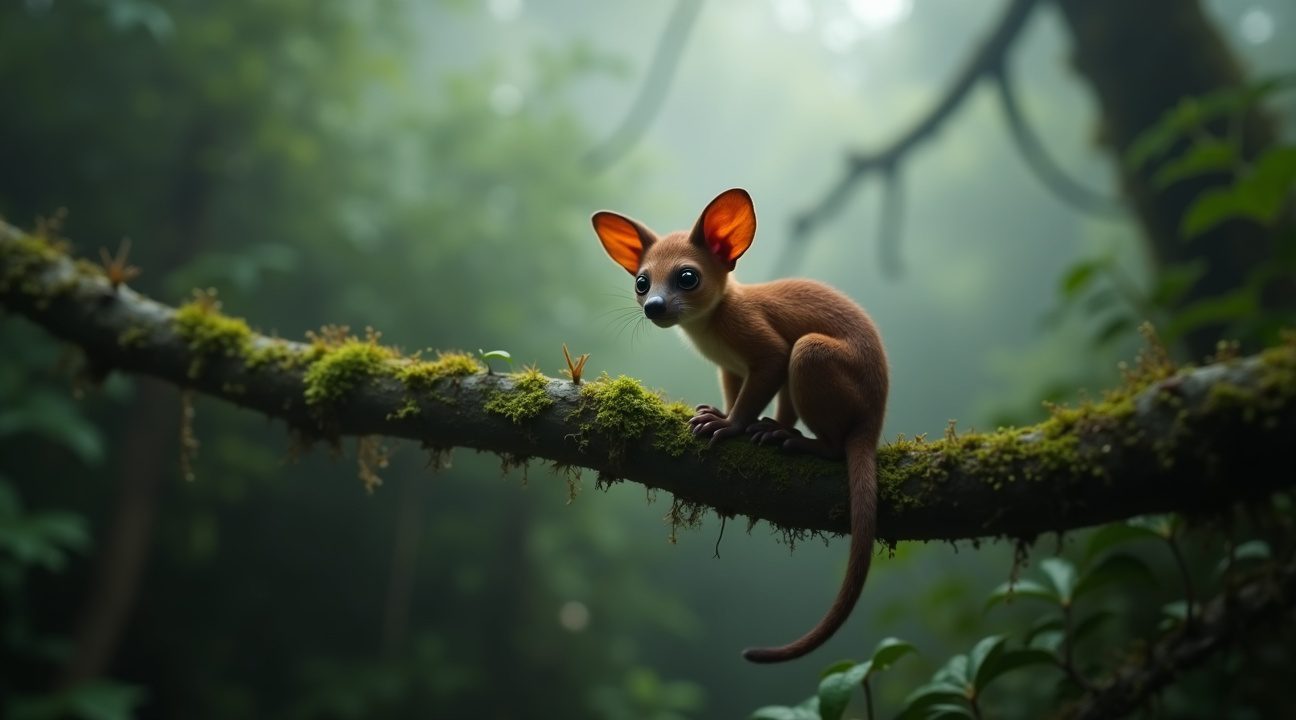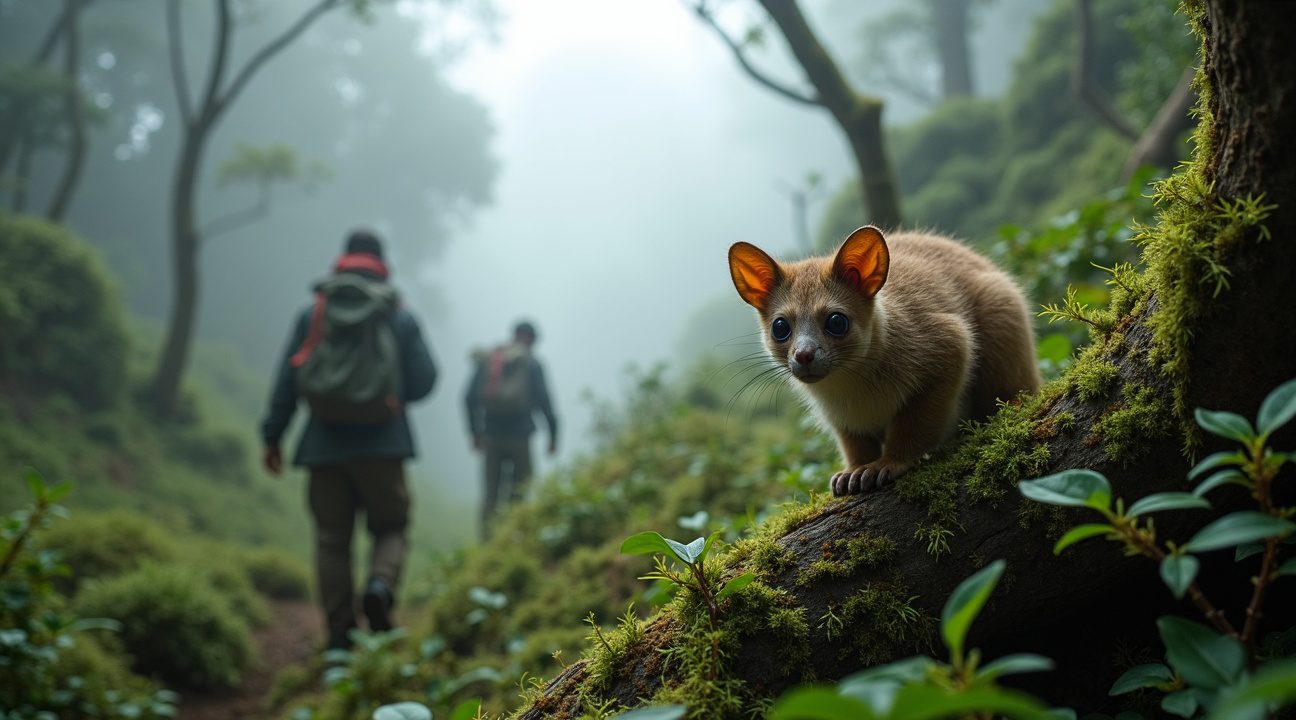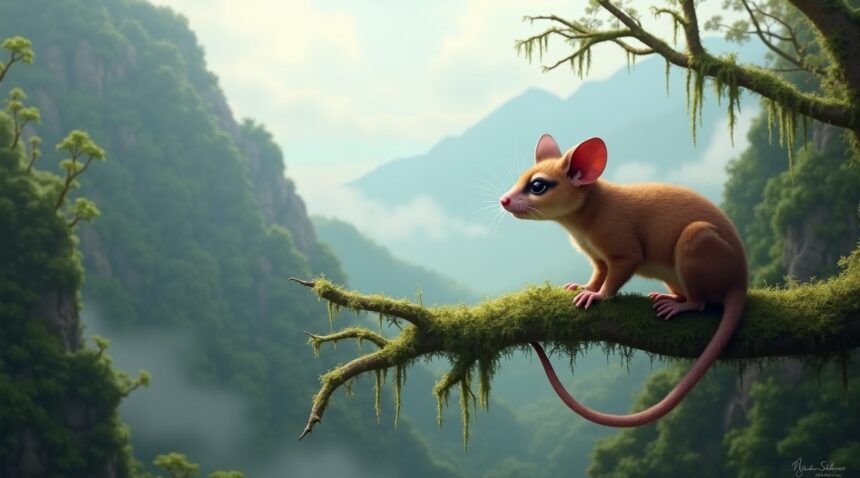Scientists made an extraordinary discovery in Peru’s remote Río Abiseo National Park, finding a new marsupial species called Marmosa chachapoya. This remarkable creature possesses ears so unusually large that they give it an almost cartoon-like appearance, setting it apart from all other known mouse opossums. Researchers found this tiny animal at an unprecedented altitude of 2,664 meters in the Peruvian Andes, shattering previous elevation records for similar marsupials. DNA analysis took six years to complete, confirming its status as a completely new species.
Key Takeaways
- Researchers discovered the mouse opossum accidentally during a 2018 expedition while searching for an entirely different species, demonstrating how much biodiversity remains hidden in remote locations.
- At just 10 cm in body length, the marsupial displays distinctive mask-like facial markings and reddish-brown fur, with ears that appear dramatically oversized compared to its small face.
- DNA analysis revealed an 8% genetic difference from its closest relative, confirming it as a distinct species after six years of thorough scientific validation involving multiple institutions worldwide.
- The discovery took place at 2,664 meters elevation in Peru’s cloud forests, significantly higher than where related marsupials typically live, suggesting unique high-altitude adaptations.
- Critical knowledge gaps remain about the species’ population size, behavior, and conservation status. With only a single specimen collected so far, future research is essential for protection efforts.
Learn More
To explore further details about this discovery and the biodiversity of the region, visit National Geographic’s full article on the newly discovered marsupial.
Tiny Mouse Opossum with Oversized Ears Found in Remote Peruvian Cloud Forest
Scientists have uncovered a remarkable new marsupial species during a 2018 expedition in Peru’s remote Río Abiseo National Park. The tiny creature, officially named Marmosa chachapoya, captures attention immediately with its disproportionately large ears that dwarf its small face, creating an almost cartoon-like appearance that sets it apart from other known mouse opossums.
Discovery at Record-Breaking Altitude
I find it fascinating that researchers discovered this mouse opossum at an elevation of 2,664 meters (8,740 feet) in the Peruvian Andes, breaking previous altitude records for similar marsupials. Most related species typically don’t venture above 1,580 meters (5,184 feet), making this discovery scientifically significant for understanding how marsupials adapt to high-altitude environments. The specimen was collected accidentally while the research team searched for an entirely different species—a mysterious squirrel—demonstrating how undiscovered species can surprise scientists even during targeted expeditions.
Distinctive Physical Characteristics
Beyond its oversized ears, Marmosa chachapoya displays several unique features that distinguish it from its relatives. The animal sports reddish-brown fur that helps it blend into the cloud forest environment, complemented by distinctive mask-like facial markings that frame its elongated snout. These characteristics suggest evolutionary adaptations to its specific high-altitude habitat, though researchers need additional specimens to fully understand these traits.
The rarity of this discovery can’t be overstated—only a single specimen has been collected so far, leaving scientists with limited information about the species’ ecology, behavior, or population status. This scarcity highlights both the challenges of studying wildlife in remote locations and the urgent need for continued biodiversity surveys in unexplored regions. Just as researchers have made surprising discoveries about unexpected adaptations in other fields, this marsupial’s unique features may reveal new insights about survival strategies in challenging environments.
The accidental nature of this discovery reinforces the importance of comprehensive fieldwork in biodiversity hotspots. Scientists often stumble upon unexpected species while pursuing other research objectives, much like how marine biologists have encountered rare creatures during routine explorations. Each expedition into remote areas like the Peruvian cloud forests potentially uncovers species that have remained hidden from science for millennia.
This mouse opossum’s discovery emphasizes how much we still don’t know about biodiversity in remote mountain ecosystems, where altitude and isolation create unique evolutionary pressures that produce species like remarkable adaptations found nowhere else on Earth.

Remarkable Physical Features Set This Marsupial Apart from All Others
Marmosa chachapoya stands out as an exceptionally compact marsupial, measuring just 10 cm (4 inches) in body length. When including its lengthy tail, this diminutive creature reaches a total length of approximately 25 cm (10 inches), making it one of the smaller members of the mouse opossum family.
Distinctive Markings and Coloration Define Its Appearance
The animal’s most captivating feature lies in its dramatic facial markings—dark patches surrounding the eyes create a distinctive mask-like appearance that gives this species an almost bandit-like quality. This characteristic is particularly striking as it contrasts beautifully with the creature’s reddish-brown coat, which gradually transitions to lighter, more subdued tones across the underside.
The fur quality itself demonstrates remarkable variation, with the rich reddish-brown coloration on the back providing excellent camouflage in its forest habitat. This coloration pattern, combined with the creature’s slender build and elongated snout, creates a perfectly adapted form for navigating dense vegetation and foraging in tight spaces.
Proportionally Large Ears Command Attention
Perhaps the most remarkable aspect of Marmosa chachapoya involves its ears, which appear dramatically oversized in proportion to its small head and face. While not technically exceeding the face dimensions, these prominent ears create such a striking visual impression that they’ve become the species’ defining characteristic in both scientific descriptions and photographic documentation.
These impressive auditory organs likely serve multiple evolutionary purposes:
- Enhanced hearing capabilities for detecting predators in the forest canopy
- Assisting in locating prey
- Facilitating communication with other species members
The ears’ proportional size creates an almost cartoon-like appearance that distinguishes this marsupial from any other known species.
The comparison with related species reveals fascinating differences. M. lepida and M. andersoni, two closely related mouse opossums, demonstrate notably different morphological characteristics when placed alongside Marmosa chachapoya. Size variations become immediately apparent, with the newly discovered species showing distinct proportional differences that extend beyond simple body measurements.
Ear dimensions particularly highlight these species distinctions. While other Marmosa genus members possess adequately sized ears for their ecological needs, none approach the proportional prominence displayed by M. chachapoya. This feature alone would allow researchers to identify the species from a considerable distance, making field identification remarkably straightforward.
The creature’s slender build complements its other physical adaptations perfectly. This streamlined body structure enables efficient movement through dense forest undergrowth while maintaining the agility necessary for arboreal locomotion. Combined with its lightweight frame, these proportions suggest an animal perfectly suited for life in the forest canopy.
Coloration patterns also separate this species from its relatives. The specific reddish-brown hue, coupled with the fade pattern observed on the underside, creates a unique visual signature that researchers can use for positive identification. These color variations likely evolved in response to specific environmental pressures within its Peruvian cloud forest habitat.
The elongated snout adds another distinguishing element to this remarkable creature’s appearance. This facial structure enhancement likely improves foraging efficiency, allowing the animal to probe deeper into crevices and small spaces where insects and other prey might hide. Such adaptations demonstrate how this species has evolved to maximize its survival potential in a highly competitive ecosystem.
Understanding these physical characteristics helps researchers appreciate how this species fits into the broader undiscovered species puzzle that continues to emerge from remote forest environments. Each unique trait represents millions of years of evolutionary refinement, creating a marsupial perfectly adapted to its specific ecological niche.
The combination of compact size, distinctive markings, and proportionally large ears creates a truly unique member of the marsupial family. These features work together to produce an animal that stands apart from all known relatives while demonstrating the incredible diversity still waiting to be discovered in remote forest habitats worldwide.

Six Years of DNA Analysis Confirmed This as a Completely New Species
Following the collection of the Marmosa chachapoya specimen in 2018, researchers embarked on an exhaustive investigation that would ultimately span six years. I can appreciate how this lengthy process reflects the careful scrutiny required to confirm a truly new species discovery. The scientific team conducted a comprehensive comparison of DNA and physical characteristics against other known mouse opossums, utilizing samples from museum collections across the globe.
The genetic analysis revealed striking results that left no doubt about this marsupial’s unique status. DNA testing showed that Marmosa chachapoya differs by approximately 8% from its closest known relative, Marmosa lepida. This level of genetic divergence represents a significant evolutionary gap that strongly supports classification as a distinct species rather than a subspecies or regional variant.
Rigorous Scientific Methods Ensured Accurate Classification
The confirmation process involved multiple sophisticated techniques that researchers employed to validate their findings:
- Genetic barcoding to identify unique DNA sequences specific to this marsupial
- Detailed morphometric measurements comparing physical features across specimens
- Extensive consultation of global reference archives from major natural history museums
- Cross-referencing with existing taxonomic databases to eliminate any possibility of rediscovery
This comprehensive approach ensured that every aspect of the creature’s biology supported its designation as a new species. Museum collections proved invaluable during this phase, providing researchers with preserved specimens that enabled direct comparisons across different mouse opossum populations. The process required careful coordination between multiple institutions worldwide, demonstrating how modern species discovery relies on international scientific collaboration.
Just as other remarkable discoveries like ancient forest ecosystems reveal hidden biodiversity, this marsupial’s confirmation highlights how much remains unknown about Earth’s species diversity. The formal species description finally occurred in June 2025, marking the culmination of this rigorous scientific vetting process.
The extended timeline reflects the high standards required for species descriptions in modern taxonomy. Unlike historical periods when new species classifications might have been based on limited evidence, today’s researchers must provide extensive genetic and morphological data to support their claims. This careful approach prevents misclassification and ensures that each newly described species truly represents a unique evolutionary lineage.
Discovery Highlights Critical Biodiversity in UNESCO World Heritage Site
The remarkable discovery of Marmosa chachapoya within Peru’s Río Abiseo National Park reinforces this UNESCO World Heritage Site’s status as one of South America’s most important biodiversity hotspots. This protected area showcases extraordinary biological richness, harboring high concentrations of endemic and endangered species that exist nowhere else on Earth.
Cultural and Historical Significance
Researchers chose to name this distinctive marsupial after the Chachapoya, an ancient cultural group that once inhabited the region centuries ago. This naming convention honors the deep historical connections between the area’s natural heritage and human legacy. The park encompasses more than three dozen archaeological sites, creating a unique intersection where biological discovery meets cultural preservation.
Beyond archaeological treasures, Río Abiseo serves as a sanctuary for some of the Andes’ rarest wildlife. The yellow-tailed woolly monkey, once presumed extinct, finds refuge within these mountain forests. Such discoveries demonstrate how unexplored habitats continue yielding scientific surprises.
Ongoing Scientific Exploration
The identification of Marmosa chachapoya emphasizes the critical importance of sustained scientific exploration and conservation efforts in these understudied ecosystems. Research teams working in Río Abiseo have identified several other potential new species, including an unnamed semi-aquatic rodent that awaits formal scientific description.
These findings highlight how much scientists still don’t understand about Andean biodiversity. Protected areas like Río Abiseo function as living laboratories where researchers can study evolutionary processes and species adaptation in relatively undisturbed environments. Each new species discovery adds another piece to the complex puzzle of how life adapts to high-altitude conditions and isolated mountain ecosystems.
Conservation efforts in this UNESCO site prove essential for protecting not just known species, but also the countless others that likely remain undiscovered. The park’s challenging terrain and remote location have historically limited scientific access, meaning many areas remain virtually unexplored by modern researchers. Continued investment in scientific exploration and habitat protection will undoubtedly reveal additional species, each offering insights into the incredible diversity that thrives in these Andean cloud forests.

Critical Knowledge Gaps Leave Species’ Future Uncertain
The discovery of Marmosa chachapoya represents both a remarkable scientific achievement and a stark reminder of how much researchers still don’t understand about cloud forest ecosystems. While scientists have confirmed this distinctive marsupial exists, virtually everything else about its life remains a mystery that demands urgent investigation.
I find it concerning that conservation experts currently lack fundamental data about this species’ population size, distribution patterns, and basic survival requirements. Without this critical information, determining whether Marmosa chachapoya faces immediate extinction risks becomes nearly impossible. The species could number in the hundreds or potentially fewer than a dozen individuals across its entire range.
Essential Research Priorities
Conservation biologists have identified several urgent research priorities that require immediate attention:
- Comprehensive population surveys to establish baseline numbers and density estimates
- Detailed habitat mapping to understand specific microclimate requirements within cloud forests
- Dietary analysis through stomach content examination and observational studies
- Reproductive biology research including breeding seasons, litter sizes, and maternal care patterns
- Geographic range assessment to determine if populations exist beyond the initial discovery site
- Ecological role evaluation to understand the species’ position in food webs and ecosystem function
The reproductive habits of this opossum remain completely unknown, leaving researchers unable to predict population growth potential or vulnerability to environmental changes. Unlike more familiar wildlife that might recover quickly from disturbances, marsupials often have slower reproductive rates that could make Marmosa chachapoya particularly susceptible to habitat loss.
Scientists emphasize that the cloud forest environment where this species was found represents one of Earth’s most threatened ecosystems. These high-altitude forests experience constant moisture from fog and clouds, creating unique conditions that support extraordinary biodiversity. However, climate change and human encroachment continue to shrink these fragile habitats at alarming rates.
Field expeditions planned for the coming years will focus on capturing individuals for detailed study while minimizing stress to wild populations. Researchers plan to use radio tracking technology to monitor movement patterns and territory sizes, providing insights into space requirements for long-term survival.
The discovery site’s location in Peru’s remote mountainous regions presents significant logistical challenges for sustained research efforts. Access requires arduous hiking through difficult terrain, limiting the frequency and duration of scientific expeditions. This geographic isolation, while protecting the species from immediate human threats, also complicates conservation planning efforts.
I recognize that developing effective protection strategies requires understanding how Marmosa chachapoya responds to habitat modifications and climate variations. Current knowledge gaps prevent scientists from predicting how the species might adapt to changing environmental conditions or whether it possesses the flexibility to survive in altered landscapes.
The scientific community has called for establishing protective corridors connecting fragmented cloud forest patches, but designing these connections requires detailed knowledge of the opossum’s movement patterns and dispersal capabilities. Without this information, conservation efforts might inadvertently overlook critical habitat features or migration routes.
Recent discoveries of undiscovered species in remote locations worldwide highlight the importance of exploring Earth’s remaining wilderness areas before they disappear. The remarkable adaptations found in isolated ecosystems often provide crucial insights into evolutionary processes and potential solutions for conservation challenges.
International collaboration between Peruvian researchers and global conservation organizations has begun, focusing on developing standardized monitoring protocols and training local scientists in advanced field techniques. These partnerships aim to establish long-term research programs that can track population changes and habitat conditions over decades.
The urgency surrounding Marmosa chachapoya research extends beyond this single species to encompass the entire cloud forest ecosystem. Scientists estimate that dozens of undocumented species likely inhabit these remote environments, making comprehensive biodiversity surveys essential for understanding the full scope of conservation needs.
Early evidence suggests this opossum might serve as an indicator species for cloud forest health, potentially helping researchers assess ecosystem stability and predict environmental changes. However, confirming this hypothesis requires extensive ecological research that could take years to complete.

Sources:
Live Science – “Mystery creature found in forbidden cloud forest of Peru is new species of marsupial”
Sci.News – “Marmosa chachapoya: New Marsupial Species Found in Peru”
ExplorersWeb – “New high-altitude marsupial confirmed in Peru”
Humboldt State University – “New Mammal Species Discovered in Peruvian Andes”


